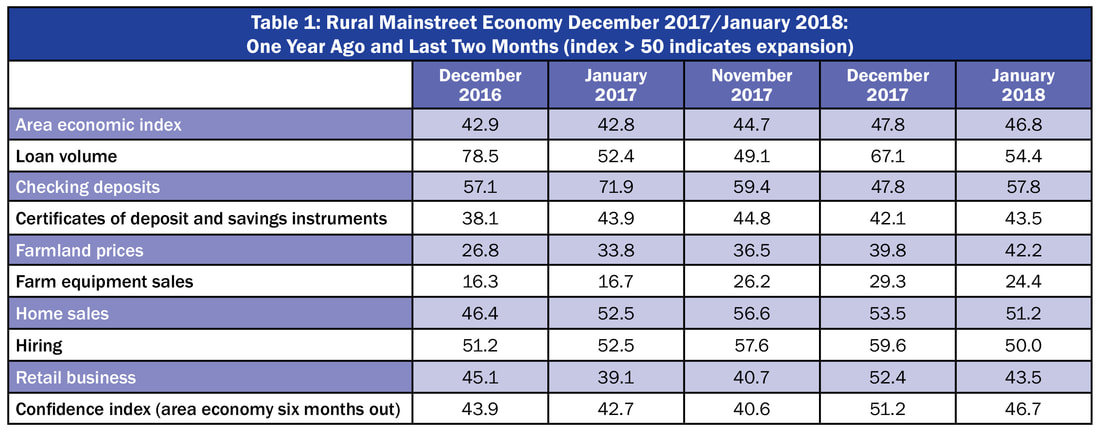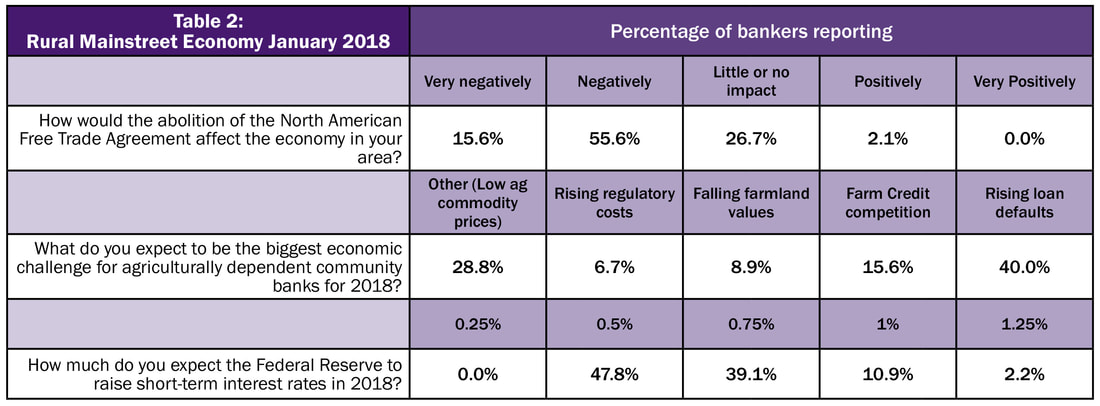- The overall index sank from December’s weak reading and remained below growth neutral.
- Approximately 40 percent of bank CEOs named rising loan defaults as the greatest economic challenge for 2018.
- More than seven in 10 bankers expect that the abolition of NAFTA would have a negative impact on their economic area.
- For the 50th straight month, the farmland price index sank below growth neutral.
OMAHA, Neb. (Jan. 18, 2018) – The Creighton University Rural Mainstreet Index declined slightly in January from December’s weak reading, remaining below growth neutral, according to the latest monthly survey of bank CEOs in rural areas of a 10-state region dependent on agriculture and/or energy.
Overall: The index, like all indices in the survey, ranges between 0 and 100 with 50.0 representing growth neutral, fell to 46.8 from 47.8 in December. Though the overall index remained below growth neutral, it is significantly higher than the reading for January 2017.
“While the overall Rural Mainstreet Index (RMI) for January declined and remained below growth neutral, year-over-year indices are trending higher. Clearly, based on our recent surveys, the negatives are getting less negative,” said Ernie Goss, Jack A. MacAllister Chair in Regional Economics at Creighton University’s Heider College of Business.
When asked to name the greatest 2018 economic challenge for their banks, four in 10 bankers reported that loan defaults represented the biggest challenges for the year ahead. This is well ahead of the second ranked challenge of competition from Farm Credit coming in at 15.6 percent.
Farming and Ranching: The farmland and ranchland-price index for January rose to 42.2 from 39.8 in December. This is the 50th straight month the index has fallen below growth neutral 50.0.
Regarding farmers that are cash renting farmland Brian Schroeder, president and CEO, Minier, Illinois, reported, “Land owners have conceded very little to this point.” However, Schroeder does expect that to change as cash rents move lower.
The January farm equipment-sales index slumped to 24.4 from December’s 29.3. This marks the 53rd consecutive month the reading has dropped below growth neutral, 50.0.
Banking: Borrowing by farmers sank for January as the loan-volume index stood at 54.4, down from 67.1. The checking-deposit index expanded to 57.8 from December’s 47.8, while the index for certificates of deposit and other savings instruments advanced to 43.5 from 42.1 in December.
Hiring: The employment gauge plummeted to 50.0 from December’s 59.6.
Confidence: The confidence index, which reflects expectations for the economy six months out, fell to 46.7 from 51.2 in December, indicating a deterioration in the economic outlook among bankers. “Concerns about trade, especially current NAFTA negotiations, and low agriculture commodity prices continue to restrain bankers’ economic outlook. Approximately 71.2 percent of bankers projected that any interruption or abolition of NAFTA would have a negative impact on their area,” said Goss.
Home and Retail Sales: The home-sales index moved lower for the Rural Mainstreet economy in January, falling to 51.2 from December’s 53.5. The January retail-sales index slumped to 43.5 from December’s 52.4.
This survey represents an early snapshot of the economy of rural agriculturally and energy-dependent portions of the nation. The Rural Mainstreet Index (RMI) is a unique index covering 10 regional states, focusing on approximately 200 rural communities with an average population of 1,300. It gives the most current real-time analysis of the rural economy. Goss and Bill McQuillan, former chairman of the Independent Community Banks of America, created the monthly economic survey in 2005.
| Colorado: Colorado’s Rural Mainstreet Index (RMI) increased to 51.7 from 50.3 in December. The farmland and ranchland-price index expanded to 43.7 from December’s 40.5. Colorado’s hiring index for January declined to 60.8 from December’s 64.9. Illinois: The January RMI for Illinois dipped 46.4 from 46.7 in December. The farmland-price index rose to 42.1 from 39.9 in December. The state’s new-hiring index fell to 50.2 from last month’s 57.5. Brian Schroeder, president and CEO, Minier, Illinois, reported, “This agricultural economic reset has impacted all producers.” Iowa: The January RMI for Iowa dipped to 47.3 from 48.0 in December. Iowa’s farmland-price index for January increased to 42.4 from December’s 39.8. Iowa’s new-hiring index for January declined to 52.1 from December’s 60.0. Kansas: The Kansas RMI for January slipped to 43.1 from December’s 43.3. The state’s farmland-price index rose to 41.1 from 38.4 in December. The new-hiring index for Kansas slumped to 43.6 from December’s 50.7. Minnesota: The January RMI for Minnesota expanded to 46.5 from 45.4 in December. Minnesota’s farmland-price index dipped to 41.1 from 42.5 in December. The new-hiring index for the state plummeted 43.6 from December’s 78.0. | Missouri: The January RMI for Missouri declined to 51.6 from 55.4 in December. The farmland-price index rose to 43.6 from 40.1 in December. Missouri’s new-hiring index fell to 60.6 from 78.0 in December. Nebraska: The Nebraska RMI for January sank to 46.3 from December’s 48.3. The state’s farmland-price index climbed to 42.1 from last month’s 35.8. Nebraska’s new-hiring index stood at a strong 60.6, up from 59.6 in November. North Dakota: The North Dakota RMI for January increased to 51.4 from December’s 52.2. The state’s farmland-price index moved higher to 43.1 from 41.1 in December. North Dakota’s new-hiring index declined to 57.2 from 68.4 in December. South Dakota: The January RMI for South Dakota sank to 40.2 from 41.2 in December. The state’s farmland-price index climbed to 40.2 from 37.8 in December. South Dakota's new-hiring index slumped to 37.9 from December’s 46.5. Wyoming: The January RMI for Wyoming slipped to 44.3 from December’s 45.7. The January farmland and ranchland-price index climbed to 41.5 from 39.1 in December. Wyoming’s new-hiring index fell to 50.2 from December’s 55.5. |
(Click each table to view larger.)



 RSS Feed
RSS Feed